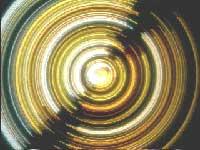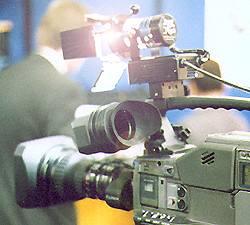|
Module 30 |
Updated: 07/30/2005 |
|
Lighting
Almost all incandescent lamps used in TV production are tungsten-halogen lamps (commonly called quartz lamps). They normally range from 500 to 2,000 watts in intensity. This type of lamp is more efficient than the common light bulb-type incandescent lamp, and it does not darken with age. Quartz lamps get extremely hot, which makes ventilation important. Because of the great heat associated with tungsten-halogen lighting instruments, burnt fingers are a hazard for the unwary. Special care must be taken when these lamps are changed (in addition to unplugging the lights and letting them cool down) to make sure that oil from fingers is not deposited on the outer glass (quartz) envelope of the lamp. Because of the great heat associated with these lamps, any residue of this sort will create an area of concentrated heat that will cause the lamp to fail-and they can be rather expensive to replace. Care must also be taken not to subject the lamp to jolts while they are turned on, or the fragile internal element can break. Tungsten-halogen lamps are used in several common types of lighting instruments; but, before we get to that, one other type of lamp should be mentioned.
|
|
HMI Lights HMI lights have several advantages over standard quartz or incandescent lights. First, compared to standard incandescent lights, they deliver five times the light output per watt. This means that they generate less heat, which is an important consideration when shooting inside in a confined space. (Incidentally, HMI stands for Hydrargyrum Medium Arc-length Iodide.)
First, lets look at the picture on the left above. The light on the left side of this picture is a HMI light; the one on the right a standard quartz light. Despite the difference in size, both put out the same amount of light. The color temperature of HMI lights is the same as average sunlight-5,600K. This makes them an ideal fill light for on-location work (where the sun is the key). The standard quartz light must use a blue filter to bring it to the color temperature of sunlight. This significantly reduces the light output when this light is used outside. The main disadvantage of the HMI light is the bulky, high-voltage power supply that's needed. (Note the power supply for the HMI light at the bottom left of the photo above.) The photo above on the right above shows the HMI element inside the lighting instrument. Now that we've covered the lamps used in lighting instruments, we can turn to the lighting instruments that house these lamps.
For several decades the Fresnel (pronounced fra-nell) light has been the primary source of illumination in most film and TV studio productions. The HMI light pictured above is a Fresnel. Although these lights used to be so bulky and heavy that they were confined to studios, recent versions are small enough to be packed away in lighting kits and used on location. The Fresnel lens in the front of the light (named for the person who devised it) consists of concentric circles that both concentrate and slightly diffuse the light. Note the photo on the left below. The coherence (quality) of the resulting light represents an ideal blend between hard and soft. In the studio these lights are typically hung from a grid in the ceiling.
A C-clamp or pipe clamp (on the right, above) is used to attach the light to the studio's ceiling grid. Because of the safety hazard a falling Fresnel light some 5 meters (17 feet) feet overhead can represent, a safety chain or cable should always be used along with the C-clamp. These wrap around the grid pipe and will keep a heavy light from falling if the C-clamp fails. The distance between the internal lamp and the Fresnel lens can be adjusted with this type of light to either spread out (flood), or concentrate (spot or pin) the light's beam. This adjustment provides a convenient control over the intensity of the light, as well as the coverage area.
Note that this scoop shown here has a filter frame attached to the front. Colored gels, diffusers, and scrims can be slid into this frame to change the light in various ways.
The ellipsoidal spot produces a hard, focused beam of light. Used with gels, it can project colored pools of light on a background. Some ellipsoidal have slots at their optical midpoint that accept a "cookie" (cucalorus), a small metal pattern (shown in red in the middle of the drawing below) that can be used to project a wide variety of patterns on a background.
In some cases, a background pattern (see samples on the left) may be all you need in a medium shot or closeup to suggest a complete setting. For example, a colored stained glass pattern behind a person would suggest that the person is in a church. Abstract patterns, or patterns suggesting the theme of a program, can also be used to break up what might otherwise be a blank background. These can either be in the form of a cookie inside the light as indicated in the drawing above, or a large pattern mounted on a stand. In the latter case these large patterns are referred to as gobos, a term which stands for "go between." When a coherent light source such as an ellipsoidal spot is directed at the pattern, a shadow of the pattern appears on the background. Backgrounds, sets, and settings are discussed in Although Fresnels, scoops, and ellipsoidal
spots are the most used types of studio lights, there are also several other types
of lighting instruments. Some of these are covered
In ENG (electronic newsgathering)
where quality is often secondary to getting a story, camera-mounted, tungsten-halogen
or HMI lights (often called sun-guns) are sometimes used
as a sole source of illumination. These lights can be mounted on the top of the
camera or held by an assistant. They are typically powered by batteries-generally, the same 12-volt batteries that power the camera. When used inside, this type of light provides the same (questionable) quality as the familiar single-flash-on-the-camera does in still photography. As a result of the straight-on angle involved, picture detail and depth are sacrificed. Because of the relationship between distance and light intensity, the detail and color of foreground objects often becomes washed out, and objects in the distance typically go completely dark. (Recall the problem with tonal mergers.) For these reasons, a camera light works best if important subject matter is all at about the same distance from the camera. These lights are often used outside in combination with a color-correcting dichroic filter to reduce harsh shadows created by direct sunlight.
Barn doors From lighting instruments
themselves, we now turn to Adjustable black metal flaps called barn doors can be attached to some lights to mask off unwanted light and to keep it from spilling into areas where it's not needed. While barn doors provide a soft cutoff (edge) to the perimeters of the light, flags provide a sharper, more defined cutoff point.
Flags consist of any type of opaque material that can block and sharply-define the edges of the light source. They are often created and shaped, as needed, from double or triple layers of aluminum foil. Flags are generally either clipped to stands or attached to the outer edges of barn doors. The further away they are from the light source, the more sharply defined the light cutoff will be.
Filter frames
are typically a part of the barn door
Each of these simply slides into the filter frame, which in turn attaches to the front of the lighting instrument. Now that we know the basics of lamps and lighting instruments, we're ready to put them into use. In the next Module we'll start with the most important light, the key light. |





 Scoops
produce a softer light than Fresnels. The incandescent (tungsten-halogen) lamps
they normally use range from 500 to 2,000 watts. Since there is no lens, the light
is not projected any significant distance. As we will see, scoops are commonly used
in the studio for fill light.
Scoops
produce a softer light than Fresnels. The incandescent (tungsten-halogen) lamps
they normally use range from 500 to 2,000 watts. Since there is no lens, the light
is not projected any significant distance. As we will see, scoops are commonly used
in the studio for fill light.




 attachments
that are used with these lights.
attachments
that are used with these lights.  attachment
that slides over the front of lighting instruments. They can hold:
attachment
that slides over the front of lighting instruments. They can hold: